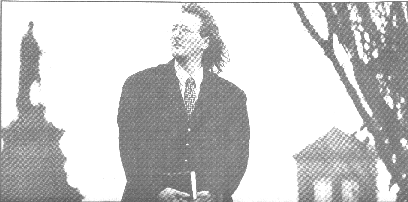
No stone unturned:
Sandy Stoddart is determined to build monuments to Scotland's forgotten heroes.
MacBRAVEHEART
The Glasgow Herald newspaper of 2nd August, 1997, carried an article by Sandy Stoddart as follows:
ALEXANDER STODDART suggests a means of proving the political unity of the nation's artists
Recovery of a people and native land

No stone unturned:
Sandy Stoddart is determined to build monuments to Scotland's forgotten heroes.
The great thing about monuments is that they can be appreciated both by the philistine and
the aesthete. When I was wee, and necessarily a philistine, I simply worshipped the Three
Commandos Monument at Spean Bridge. How I wanted to be a soldier like that and to carry a
wonderfully rectilinear pack on my back, and to attain an equally rectilinear look of
determination and sheer unmitigated bravery for my infant jaw. Then I grew up and became
an aesthete, affecting the attire of Nausea.
I began to appreciate the modelling of the work, as a sculpture, and made thoroughly
boring observations about its ultimate descent from Rodin, and the French
clay-gesturalists. Scott Sutherland, the sculptor, had after. all worked in Paris for a
short spell earlier in the century. Then something happened. Both my youthful inclination
towards a healthy, conceptual philistinism, and my powers of aesthetic appraisal undertook
an immense surge. I discovered that I had been right first time, and that soldiers are
much more interesting than sculptures. And at that moment I became a political artist.
Yes, all the old Athenian anxieties about Sparta came fretting around again. Let me
explain. The ancients, and indeed the moderns too, had and have an idea that in Sparta
there were, with perhaps the exception of Alcmaeon, no poets. It is the thought of the
state having rid itself of the pack of lies, the sybaritic critic-type, the collector and
the decadent that comes, to the man of true taste, as a vision of beauty in itself.
This is more handsome than any picture. Tragically, the yearning afer such a vision is the
prerogative only of the artist. Thus Rousseau, consummate prose-turner, man of feeling and
taste, wins the Dijon essay competition by concluding that the development of the arts is
bad for mankind. When the Spartan king Agesilaus was told ot. a musician imitating the
song of the nightingale in the agora of Lacedaemon, "no I shall not come," he
said, "for I can hear the nightingale herself."
We might stoop to draw existentialist parallels from that to the likes of Gilbert and
George, yet Agesilaus himself really meant it. The Spartans had no word for actors, they
called them all buffoons.
The monument is really a mean term between the soldier and the sculpture. Its precise
lexis consists in the language of statuary. A statue is made of sculpture, but its
sculpture is there to be concealed by the work's meaning, dedication, votive function. In
this way the sculpture strides out of its formalist cage and enters the world of continent
mental life.
It must be so, for statuary is consistently excluded from the attentions of the
contemporary arts authorities. Furthermore, statuary is able to breed with history, and
history is what makes politics. In the contemporary art world, thoroughly depoliticised as
it is (possibly an "ultra-cultural" stroke of genius by Mrs Thatcher in the
eighties) there is a determined policy, promoted by the Scottish Arts Council and other
"enabling" bodies, to exclude art that relates to history - and let us specify
Scottish history, since there is no other that really matters a damn, yes?
This is why I believe that a Scottish Monumentalism, recovered in our time, is a means of
proving the political utility of the nation's artists in this most significant moment of
Scotland's history for 300 years. It's even more important than the Disruption of 1843.
State revolutions have always been attended by the artists, and they certainly were
present in the time of Welsh and Chalmers.
It is, however, quite disgusting to see today how the generality of Scotland's artists,
swivelling in a pus-pot of irony and "wit", seeks renown in the international
art closet of Los Angeles/Cologne/Venice, while its country convulses in yet another birth
pang, deserted as a subject, despised as a location. Only Scotland could have a national
sculptor, Paolozzi, who disdains to live in the benighted territory, and is so
sucked-up-to by the Anglo-British plants in cultural power.
The provisional, devolved period in the history of Scotland's recovery of total autonomy
will, as announced last week, have its wee £50m "meaner and greener"
debate-facility building, built on some available site, probably in Leith. But when true
authority is won (and I think it shall not be given, but rather taken as it logically
must) then the first question ideally should be not "how much will the tax be,"
or "what about the office-provision." but "Who, among the national dead,
has been the most unjustly forgotten, and how shall his or her monument look."
And if this question can even just be asked, then we will have taken a serious step
towards the recovery of a people, a history, and a native land. We shall have a statue of
Lord Belhaven, who warned us, on the eve of Union.and who was laughed at by some scum of
the earth.
So we want dances more than we want dance, and pictures more than we want paintings. We
want monuments more than statues, and statues more than sculptures. Most of all we want
anything, yes even Douglas Gordon's buttock-clenchingly boring "Trust Me"
tattoo. Anything rather than scul?ture. Do you know what I mean?
Alexander Stoddart expounds his views on Wednesday 6th August, 1997, in One
Foot in the Past (British television: BBC2 8pm).
Monuments Index | Scottish History
Braveheart @ MacBRAVEHEART homepage
